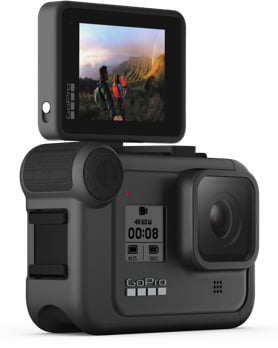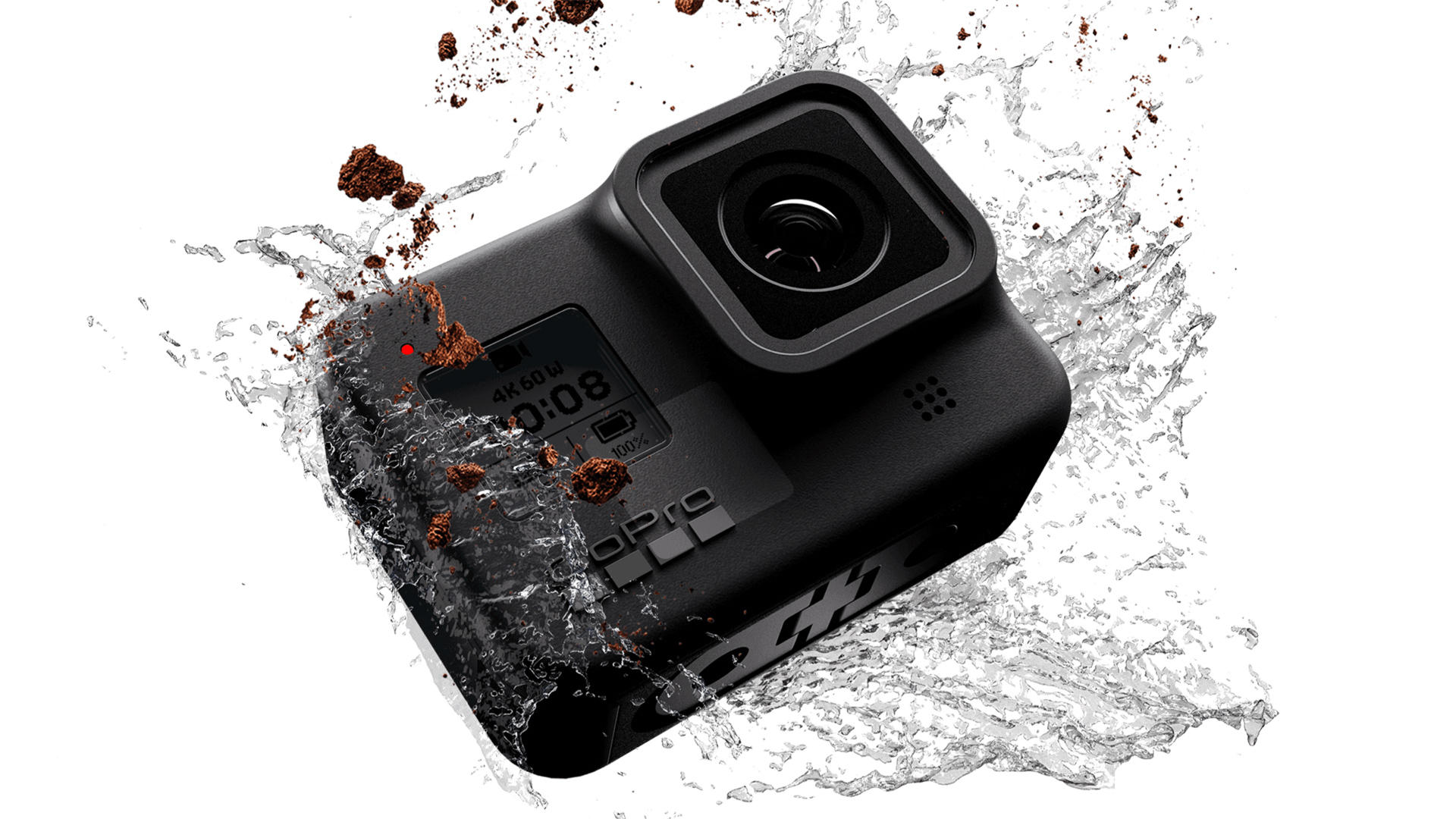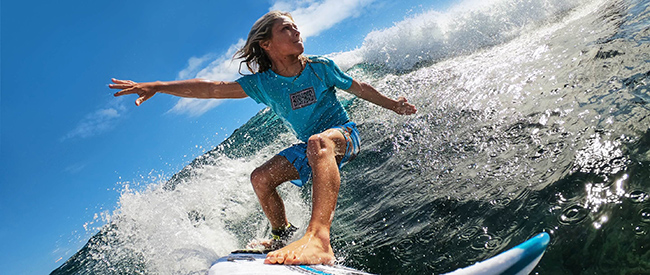

GoPro's Hero 8 is now here, along with a new 360 camera called the Max. What do the new cameras have to offer?
In stark contrast to previous years, the release of the new GoPro cameras came as a livestream of the now obligatory action reel we have no come to expect. No presentation from Nick Woodman, no stage. The company let the footage speak for itself. Interestingly although two new cameras have been announced today, the trailer only contained footage from the Hero 8 Black.
So what's new?
Hero 8 Black
The Hero is by far the most popular camera in GoPro's range. But the company has in the past been accused of being too iterative. It's a point of view that I disagree with because there's only so much you can do with current technology in terms of true innovation and capability. But with the Hero 8 there are a number of compelling features. Many of which may not come as a surprise to any who had caught sight of the various leaks making their way onto the internet the last few months.
It's the externals of the Hero 8 where the biggest changes have been made. It looks superficially like the Hero 7, but this is slightly deceiving. The body itself contains two flip down mounting points for attaching to GoPro mounts. This sounds a small thing, but in practice it means that there is no longer any need for the camera to be mounted in a 'frame'.
The effect of this is twofold. Firstly it makes the camera smaller in size once attached to a helmet etc, and second it just makes things look neater all round. Current users of previous cameras will be relieved to hear that batteries from the Hero 6 and up will work with the 8.

The user interface on the Hero 8 is customisable
Interestingly the new camera features a lens that is apparently 2x stronger than the previous camera. This is notable because the new design does not have a replaceable lens like the previous one. When GoPro refers to the lens it is really referring to the outer lens protector, since this is the part that takes all the punishment. This means that owners of accessories such as the PolarPro ND filters will not be able to use them on the new camera. This was done no doubt to simplify the manufacturing process.
The optional Media Mod (£79.99) is a new type of frame option for the camera that has a flip up LCD screen for vlogging. It also features two shoe mounts for mounting an optional LED light, as well as a microphone and HDMI out ports. The Media Mod will be available from December, although you will need to purchase the lights and screen accessories separately.
Internally there have been some tweaks to improve both performance and the user interface. The hero 8 uses the same GP1 chip as the Hero 7, but there's no indication as to whether it has the same RAM. We would assume there has been some improvements to allow the new features, but until the specs come out in detail we won't know. The GoPro site does tell us that the 4K video of the Hero 8 is around 100Mbps, as per the previous model.

The new Media Mod allows light, microphone and Vlogger style LCDs to be attached to the camera
Smooth as
Hypersmooth has been improved, and is now called Hypersmooth 2.0. It was a given that this would receive continued improvement. The main standout part is that Hypersmooth now works in every single resolution and frame rate setting, including the ultra high frame rate ones such as 120 and 240fps. This means a lot of added flexibility in how the camera can now be used to get stable footage. Hypersmooth 2.0 has automatic horizon levelling, as well as multiple levels of stabilisation to help you get more natural movement when full on Hypersmooth is overkill, but you still want some stabilisation. There's even a Boost function, although GoPro are being a bit vague as to what this actually does.
More has been made of the digital zoom feature, what GoPro is calling "Digital Lenses". A tap on a very clear UI function lets the user switch quickly between Superview, Wide, Linear, and Narrow.
These digital zoom functions were played down on previous cameras, mainly because the quality can degrade quite substantially, particularly in Narrow modes. We haven't yet seen an uncompressed example of these in action, but could we speculate that much better processing allows these modes to be much more usable now?
Timewarp is now Timewarp 2.0, and lets users speed up or slow it down, so you could for example go flying through a city and then slow down to realtime once you frame a subject such as a person at certain points.
Superphoto mode performs HDR processing on images to produce what GoPro claims are pictures with detail you never thought possible. Although I will reserve judgement until I've tried it on a typical murky day surfing on the British coast!

An example of Superphoto mode
Live Burst would appear to be similar to the 4K photo burst on Panasonic cameras. It takes a burst of shots in 4K resolution over 3 seconds, recording 1.5 seconds before you've pressed the shutter and 1.5 seconds afterwards. You can then pick the still you want from the sequence, or just post the 3 second clip to somewhere like Instagram.
Nightlapse Video takes a Timelapse in video form, you've guessed it, at night, while the live streaming on the camera has been improved to transmit 1080p video.
As mentioned earlier, the camera has some user interface tweaks, including the ability to create custom shortcuts so it's much easier to find your most commonly used settings and modes.
There has been some comment online that the Hero 8 is just a 7 with a firmware update. I should point out that such assertions are rarely founded in reality. It would be very surprising indeed if there weren't significant changes under the hood to make the new Hypersmooth capabilities possible for one thing.
GoPro Max
Strangely the Max didn't feature on the main presentation video, which was odd to say the least. No matter, GoPro's replacement 360 camera is here, and as far as features go, it looks very good indeed. GoPro has been under increasing pressure from highly capable competitors in this field, so the Max needed to be good.

GoPro claims it is three cameras in one. You can shoot single lens Hero style video, 360 footage, or Vlog using the front facing screen and a microphone that performs like a shotgun mic.
Many of the same features that are on the Hero 8 also appear on the Max, except with a 'Max' moniker appearing in front, such as Max Hypersmooth, Max Superview, and Max TimeWarp.
Notably functions such as the aforementioned TimeWarp function gain a whole new level of flexibility once you can pan and reframe the shot through 360 degrees during editing, making for some very dynamic sequences in the right hands.

The Max features 5K sensors capable of up to 30P in 360 mode. The usual caveat with 360 degree cameras applies here in that once you output the final video you will only be seeing 1080p as the viewing resolution, and even in Hero mode it only goes up to 1440p at 60p. So if you need or want 4K the Max won't give that to you.
There are certainly some compelling reasons to look at the Max. The way GoPro has been making strides to make editing 360 video easy, as well as a focus on using the feature to reframe and make traditional non-VR style videos means that there's a lot of areas where such a camera would be useful.

Do you go for the Max or the Hero 8? Well, the Hero 8 costs £379, while the Max comes in at £479, so if price is your stumbling block, the Hero 8 will clearly win. Otherwise it depends on the effort you put into your videos and whether you need the slow motion and high frame rate functions of the Hero. It would appear that you gain as much as you lose depending on which one you go for. The Hero 8 for example can go to 10m water depth without a housing, while the Max only goes to 5m. The output resolution is another area of consideration. If you need 4K then you absolutely have to have the Hero 8. But if normal HD resolutions don't bother you then the Max might well be a good choice.
Decisions, decisions!
Both cameras are available for Pre-Order now. The Hero 8 will ship around Oct 15th, while the Max will ship around Oct 25th. Below is the full sizzle reel, which GoPro has now released.
Tags: Production


Comments